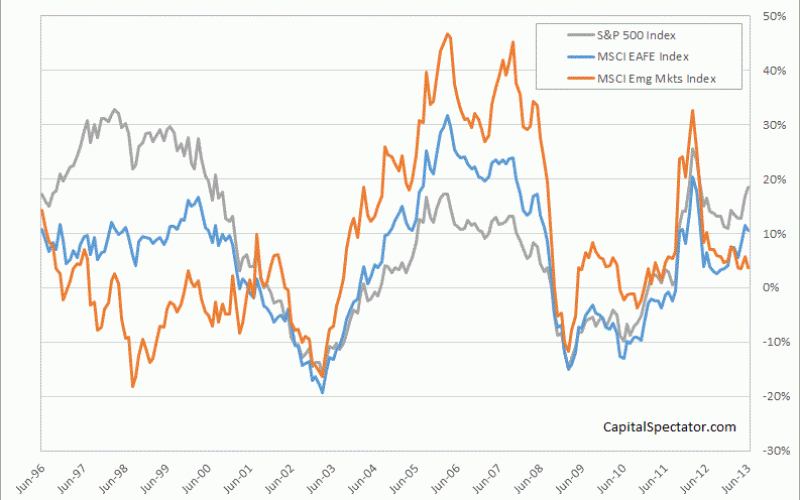Narrative Risk
The Economist tells us that “the emerging market slowdown is not the beginning of a bust. But it is a tuning point for the world economy.” Growth, to cut to the chase, will be lower in China and across the emerging market realm. Some pundits look at this reasonable assumption and warn that it’s the beginning of the end; we’ve crossed the Rubicon as it relates to the global economy and international investing. Actually, there’s far less drama to this story. Narrative risk, as Barry Ritholtz explains, may be lurking. Indeed, if you’re looking at the evolution of emerging markets through the prism of certain media headlines of late, the end appears to be nigh, at least for this week.
Perhaps the bigger issue is one of managing expectations. Emerging markets have had a good run, an extraordinary run, in fact, if you choose your look-back period carefully. But let's think about this from a different perspective. Consider rolling three-year annualized returns for these countries in comparison with the US stock market (S&P 500) and foreign equities in developed markets (MSCI EAFE). By this standard, the track record for emerging markets looks a bit more complicated from an investment angle. Indeed, there are periods of above- and below-average performance. Shocking, isn’t it?
In the late-1990s, I recall talking to numerous financial advisors who complained that they had been sold a false bill of goods. Emerging market equity funds at the time were an innovative concept, and one that relatively few investors had embraced. A few early adopters jumped on the bandwagon, largely because of several influential research studies that highlighted the impressive track record in these stocks. As an added bonus, the diversification benefits were potent, i.e., return correlations were quite low vs. US and foreign-developed-market stocks.
But the cult of equities in, say, 1999 was dominated by US stocks. It was hard not to notice, with the S&P 500 routinely delivering 20%-to-30% annual returns. Owning emerging market stocks, by contrast, looked like a wet dish rag as the new millennium approached.
Since then, emerging market stocks have rallied, crashed, and rallied again. Something similar can also be said about US and foreign developed-market stocks, albeit in varying degrees. But now we’re told by some that the party’s over for emerging market stocks, or at least that the celebrations from here on out will be toned down by more than trivial amounts.
The truth is that we didn’t wake up today and find that what had been an extraordinary investment opportunity last night had suddenly become dirt. The real story is that as the world has become increasingly globalized, and markets have become ever more securitized, expected return for the long run generally has inched down. This is almost certainly true for emerging market stocks, but it’s no less relevant for the rest of the planet’s equities (and bonds, real estate and commodities). For the same reason that you should expect that Apple’s growth rate will slow in the years ahead relative to history, the same applies to emerging markets. The low hanging fruit of return has been picked. We've been here before, with countries, with asset classes, and individual companies. Trees don't grow to the sky.
But there's more to this story. From an asset allocation perspective, it’s prudent to assume that expected return is in constant flux in shorter periods. Yes, as I discussed last week, it’s reasonable to assume that diversification benefits will fade through time. Earning a risk premium is going to get tougher, all else equal. Gravity prevails eventually.
This isn’t news, even if it’s tempting to treat it as such. If you think you've heard this somewhere before, you're right. The ancient writings a la the efficient markets hypothesis and the capital asset pricing model imply that the "market" portfolio's return is likely to trend lower rather than higher over time. The rate of decline is unknown, but it's tempting fate to assume that the performance of beta in the coming decades is going to rise.
This isn’t a new development; it’s been with us all along. It’s hardly a smooth process where, say, expected return drops by five basis points every year like clockwork. And just to keep things interesting, the process reverses itself at times and ex ante performance goes up. Over longer stretches, however, it’s going to be tough to escape the terminal slide. In a world crawling with institutions armed to the teeth with computer-based quantitative strategies, searching through every nook and crevice of markets, the long, slow descent of risk premia will yield to financial gravity.
That said, it’s a mistake to focus on one piece of the major asset classes and single it out for abuse.
What hasn’t changed is that over shorter periods there will be quite a lot of volatility in expected return, for all the asset classes. What should we do? More of the same. Diversify broadly (which is about as hard as falling asleep) and spend most of your time on designing and managing a rebalancing strategy.
Oh, yes, one more thing: Don’t get tangled up in narrative risk. Why? Because turning points, in both major and minor forms, are a dime a dozen—there’s always another one coming.











